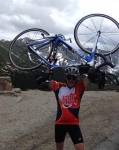Questioning is smart. That is what wisdom is all about. So I would think twice, but I wouldn't necessarily give up on the whole idea until I had thoroughly checked all the angles.Balding_Eagle wrote: . . . I am starting to question the wisdom in attempting this trip. . . .
Hiking at High Altidudes
Re: Hiking at High Altidudes
Re: Hiking at High Altidudes
Where are you going??
Can you do a test run some place that will
simulate your trip??
I'm a big fan of the shake down run.
Can you do a test run some place that will
simulate your trip??
I'm a big fan of the shake down run.
"If your therapy is improving your health but you're not doing anything
to see or feel those changes, you'll never know what you're capable of."
I said that.
to see or feel those changes, you'll never know what you're capable of."
I said that.
-
azhosehead
- Posts: 16
- Joined: Mon Jan 04, 2010 7:46 am
Re: Hiking at High Altidudes
I have taken my Resmed CPAP to altitudes of 9000 ft and had no problems. Camping out in a tent, I tend to have longer sleep times, feel good, and I like it a lot. I had to do a fair amount of research though.
On Resmed web site, they provide specs for what kind of power a battery needed to power your CPAP for say like 8 hours. I also had to purchase a "pure sine wave" inverter vs. the kind that you can get just about anywhere. I purchased a glass mat deep cycle battery rated at 75amh. If you want to reduce power usage, don't use a humidifier (yeah it dries the nose & throat). My actual machine (minus humidifier) doesn't use that much power.
Here are the challenges: are you back packing or base camping from a car? My battery weighs like 60 pounds so it is impractical to carry. I have seen some small rechargeable travel batteries that are pretty expensive. I checked on some semi large solar panels at Costco and think they cost $400-$500 based on the size. It gets a little difficult to translate the voltages vs. amps but I found that a solar panel could provide the equivalent to a "trickle charge" to the battery which translates to time. If figured that I would need 2 batteries if I used solar panels in a fixed "base" location. Let one charge for a day and use the other at night and rotate them out. Lastly, I really like solar stuff but you can't forget the one drawback: cloudy and rainy days. The electric output drops significantly during those times for photo-voltaic panels.
If you have the money to make the investment, go for it!
Good luck...
On Resmed web site, they provide specs for what kind of power a battery needed to power your CPAP for say like 8 hours. I also had to purchase a "pure sine wave" inverter vs. the kind that you can get just about anywhere. I purchased a glass mat deep cycle battery rated at 75amh. If you want to reduce power usage, don't use a humidifier (yeah it dries the nose & throat). My actual machine (minus humidifier) doesn't use that much power.
Here are the challenges: are you back packing or base camping from a car? My battery weighs like 60 pounds so it is impractical to carry. I have seen some small rechargeable travel batteries that are pretty expensive. I checked on some semi large solar panels at Costco and think they cost $400-$500 based on the size. It gets a little difficult to translate the voltages vs. amps but I found that a solar panel could provide the equivalent to a "trickle charge" to the battery which translates to time. If figured that I would need 2 batteries if I used solar panels in a fixed "base" location. Let one charge for a day and use the other at night and rotate them out. Lastly, I really like solar stuff but you can't forget the one drawback: cloudy and rainy days. The electric output drops significantly during those times for photo-voltaic panels.
If you have the money to make the investment, go for it!
Good luck...
- Balding_Eagle
- Posts: 15
- Joined: Thu Jan 14, 2010 9:17 am
- Location: New Jersey
Re: Hiking at High Altidudes
I have contacted CPAP.com and most units are only rated up to 7,500ft. The Everest was rated up to 8,000ft. I also spoke with a Respironics engineer. Although they didn’t test the units above 7,500ft sounds like there may be solution by raising my pressure to compensate. He told me to contact my home healthcare provider to have them speak to Respironics to work out the numbers. I will reach out to them next week.plr66 wrote: [I would second the suggestion that you contact cpap.com and a Respironics engineer to get a reliable answer to your question about altitude affecting your cpap's functioning properly. I very much hope that you will post the results of your research!
Philmont Scout Ranch Cimarron, NM. While I can simulate the camping, hiking and even the solar panel (once I make arrangements for a field test) aspects I cannot simulate the altitudes here in NJ. We are planning a short weekend shake down hike end of March on the Appalachian Trail.carbonman wrote:Where are you going??
Can you do a test run some place that will
simulate your trip??
I'm a big fan of the shake down run.
I am confident in the performance of the C-222 battery due to prior experience and I think I can work out the solar panel. The only thing left is altitude adjustment.
If all works out the only stumbling blocks will be to convince Philmont to allow me to attend and lose about 20 pounds or so to meet the weight requirement. I have a year and half to lose the weight, so that should not be a problem…. I hope
Re: Hiking at High Altidudes
I initally laughed when I saw your post, but after a little research it is not that far fetched. The C222 is a 222 watt-hour battery. Assuming you can stop for 4 hours during the day when the sun is high and charge the battery, you could get by with a 55 watt solar panel, which is typcially in the 31 x 21 inch range. So, IF you are willing to lug the cpap machine, the C222 battery, and a solar panel, AND stop for 4 hours to recharge, then it is technically feasible.
If you plan on hiking all day and just strapping the solar panel to your head, that is a little more unbelievable. You would have more time to charge the battery, but would have to be constantly adjusting the panel to point toward the sun. I would be impractical to strap the solar panel to your backpack unless you plan to walk away from the sun each and every day/hour of the day!
If I were going to do something like this, I think a more practical approach would be to get some sort of fuel cell that could run off of some fuel source, like liquid alcohol. You would elimintate the weight of the storage battery, and the need to point the solar cell during the day at the sun. I would also look at getting a used cpap machine, ripping it apart, and discarding all the fancy "extra" elements. Maybe just have a dc motor with high efficiency switching regulator control, and a simple pressure gauge reading to manually set the motor rpm for the proper pressure. ANything to get the current draw down to the bare minimum.
If you plan on hiking all day and just strapping the solar panel to your head, that is a little more unbelievable. You would have more time to charge the battery, but would have to be constantly adjusting the panel to point toward the sun. I would be impractical to strap the solar panel to your backpack unless you plan to walk away from the sun each and every day/hour of the day!
If I were going to do something like this, I think a more practical approach would be to get some sort of fuel cell that could run off of some fuel source, like liquid alcohol. You would elimintate the weight of the storage battery, and the need to point the solar cell during the day at the sun. I would also look at getting a used cpap machine, ripping it apart, and discarding all the fancy "extra" elements. Maybe just have a dc motor with high efficiency switching regulator control, and a simple pressure gauge reading to manually set the motor rpm for the proper pressure. ANything to get the current draw down to the bare minimum.
- Balding_Eagle
- Posts: 15
- Joined: Thu Jan 14, 2010 9:17 am
- Location: New Jersey
Re: Hiking at High Altidudes
There are people here with a lot more knowledge of Solar Panels than I have. To clarify I was planning on using Battery Geek's SOLAR CPAP BATTERY SYSTEM. This new military grade paper-thin solar panel charger recharges the C-222 from a complete discharge in approximately 8 hours. Folded up this solar panel is 4 inches long by 14.5 inches tall. Unfolded this solar panel is 79.75 inches long by 14.5 inches wide. Weight is 1.8 lbs.
Since I can easliy get 3-4 days out of the C-222, I was thinking I would need to charge around 2-3 hours a day. Do my numbers work? The only problem is my charging time will most likely be later in the afternoon. How will that affect charging times?
Since I can easliy get 3-4 days out of the C-222, I was thinking I would need to charge around 2-3 hours a day. Do my numbers work? The only problem is my charging time will most likely be later in the afternoon. How will that affect charging times?
Re: Hiking at High Altidudes
"Since I can easliy get 3-4 days" are you sure about that? I assumed you would get barely one day out of a battery charge, and have to recharge it again the next day.
- Balding_Eagle
- Posts: 15
- Joined: Thu Jan 14, 2010 9:17 am
- Location: New Jersey
Re: Hiking at High Altidudes
I am positive about it. I have done it on more than one occasion. Keep in mind I am not using the humidifier and I am only sleeping 6 to 7 hours a night.spanz wrote:"Since I can easliy get 3-4 days" are you sure about that? I assumed you would get barely one day out of a battery charge, and have to recharge it again the next day.
- billbolton
- Posts: 2264
- Joined: Wed Jun 07, 2006 7:46 pm
- Location: Sydney, Australia
Re: Hiking at High Altidudes
You my find the article titled Traveling with CPAP - all the way to the top in the latest issue of Resmed's Snooze News, of interest.
Cheers,
Bill
- "None of these facts were enough to stop Paul Philips from wanting to climb Mt Kilimanjaro. Nor was he put off by the fact that he relies on a
CPAP machine to manage his OSA, and that he would be sleeping at altitudes of up to 4700 metres above sea level—but that CPAP machines
are designed to operate only up to 2691 metres."
Cheers,
Bill
- Balding_Eagle
- Posts: 15
- Joined: Thu Jan 14, 2010 9:17 am
- Location: New Jersey
Re: Hiking at High Altidudes
Bill
Thanks for the article, it was helpful. I spoke with my DME and it looks like we are going to be able adjust my machine to compensate for the higher alivations by increasing my pressure. The problem now is my battery life will be shorter. Unlike the gentleman in the article I will not have 51 porters to carry equipment or extra batteries. I have to lug all my own gear.
Jury is still out on whether this trip is feasible or not......
Thanks for the article, it was helpful. I spoke with my DME and it looks like we are going to be able adjust my machine to compensate for the higher alivations by increasing my pressure. The problem now is my battery life will be shorter. Unlike the gentleman in the article I will not have 51 porters to carry equipment or extra batteries. I have to lug all my own gear.
Jury is still out on whether this trip is feasible or not......
Re: Hiking at High Altidudes
I would check with others before accepting that 'just' raising your pressure (otherwise not always a good idea) is the answer. I wonder how qualified that person is to really give out that advice.
Re: Hiking at High Altidudes
I agree.Julie wrote:I would check with others before accepting that 'just' raising your pressure (otherwise not always a good idea) is the answer. I wonder how qualified that person is to really give out that advice.
It is my understanding that a perfectly healthy adult can have periodic breathing at high altitudes, especially while asleep. Increasing the pressure could actually make that problem worse for some people, I would assume--although I am certainly no professional or expert on the subject, that's for sure.
The thing is that at high altitudes, I don't think that increasing PAP pressure would correct the issues with the content of the atmosphere. And wouldn't increasing pressure also increase the venting? I have no idea what that would do to CO2. Altitude issues can be more about centrals than about obstructive issues, and all that can interrelate differently for different patients. Just to be clear, I only throw those terms around, not because I understand the issues at all, but only to make the point that I do NOT understand all the issues. So I agree with Julie that it would be good to be sure the person giving the advice DOES understand all the issues.
PAP therapy is relatively new. Altitude issues with breathing are a special area that not all docs and RTs may be experienced with. Mix those two facts together, and I would be very careful about whom I took advice from. It would have to be someone who had some experience with both and knew my case history for me to feel comfortable taking advice from him or her.
jeff
Re: Hiking at High Altidudes
I'll just repeat what I posted earlier. My M Series machine (Auto with A-flex) seemed to work without any problem (and without any pressure adjustments) at altitudes as high as 13,500 feet. If it was me, assuming I could work out the battery logistics, I'd just go on the trip and enjoy myself.
_________________
| Machine: AirSense 11 Autoset |
| Mask: DreamWear Nasal CPAP Mask with Headgear |
| Additional Comments: Oscar software Previous Masks: Airfit P10 Nasal Pillow, Swift FX Nasal Pillow, Comfort Curve, Opus, Mirage Swift II |
- Balding_Eagle
- Posts: 15
- Joined: Thu Jan 14, 2010 9:17 am
- Location: New Jersey
Re: Hiking at High Altidudes
As I mentioned before I was in contact with Respironics and as confirmed by the article BillBolton posted the CPAP machine can be adjusted for the higher altidudes. Respironics would not tell me what I needed to do, but will instruct my DME. The DME is not randomly adjusting the pressure.
On another note does anyone have any further advice on the solar panel plan? I was also hoping to use a kinetic device as a backup but it appears the technology is not developed enough for my needs at this time.
On another note does anyone have any further advice on the solar panel plan? I was also hoping to use a kinetic device as a backup but it appears the technology is not developed enough for my needs at this time.
- billbolton
- Posts: 2264
- Joined: Wed Jun 07, 2006 7:46 pm
- Location: Sydney, Australia
Re: Hiking at High Altidudes
That is precisely what the altitude adjustment setting on a xPAP machine does..... it raises the "sea level" pressure by about 1.5 centimetres H20 for every 600m or so of altitude increase, then spoofs the LCD display to show what the "effective delivered" pressure is at that alititude. While most xPAP machines say that their maximum delivery pressure is 20cm H20 (and that is where the straighforward pressure settings stop), they can usually deliver up to 26cm H20 (at sea level) to allow 20cm H20 delivery at 2400m altitude (using the altitude adjustment settings).Julie wrote:I would check with others before accepting that 'just' raising your pressure (otherwise not always a good idea) is the answer.
The altitude adjustment settings xPAP machine generally stop at around 2400m (which is the equivalent atmpspheric pressure level used in commercial aircraft cabins), but if your titrated pressure is lowish to start with, you can manually work out what the equivalent sea level pressure setting should be to achieve the same effective titrated pressure air delivery at any altitude up to the maximum sea-level pressure delivery capability of the xPAP machine.
Cheers,
Bill













